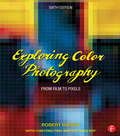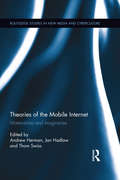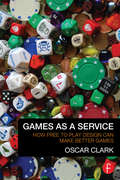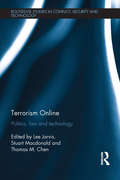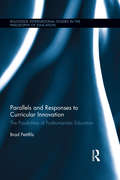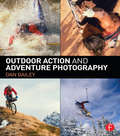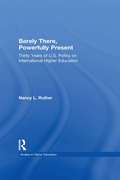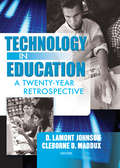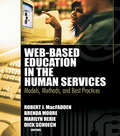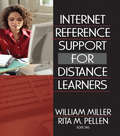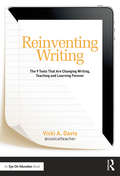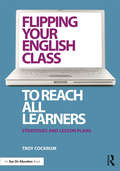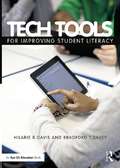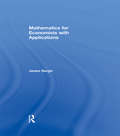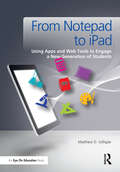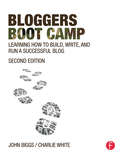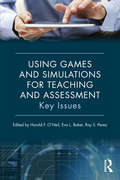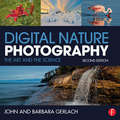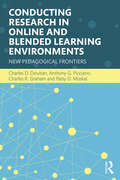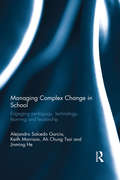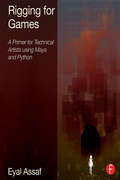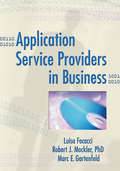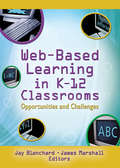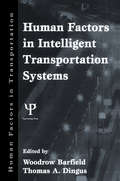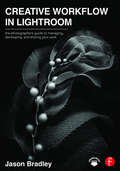- Table View
- List View
Exploring Color Photography: From Film to Pixels
by Robert HirschRobert Hirsch's Exploring Color Photography is the thinking photographer's guide to color imagemaking. Now in its sixth edition, this pioneering text clearly and concisely instructs students and intermediate photographers in the fundamental aesthetic and technical building blocks needed to create thought-provoking digital and analog color photographs. Taking both a conceptual and pragmatic approach, the book avoids getting bogged down in complex, ever-changing technological matters, allowing it to stay fresh and engaging. Known as the Bible of Color Photography, its stimulating assignments encourage students to be adventurous and to take responsibility for learning and working independently. The emphasis on design and postmodern theoretical concepts stresses the thought process behind the creation of intriguing images. It's extensive and inspiring collection of images and accompanying captions allow makers to provide insight into how photographic methodology was utilized to visualize and communicate their objectives. The text continues to deliver inspiring leadership in the field of color photography with the latest accurate information, ideas, commentary, history, a diverse collection of contemporary images, and expanded cellphone photography coverage. A "Problem Solving and Writing" chapter offers methods and exercises that help one learn to be a visual problem solver and to discuss and write succinctly about the concepts at the foundation of one's work. Exploringcolorphotography.com, the companion website, has been revamped and updated to feature more student and teacher resources, including a new web-based timeline: As It Happened: A Chronological History of Color Photography.
Theories of the Mobile Internet: Materialities and Imaginaries (Routledge Studies in New Media and Cyberculture)
by Andrew Herman Jan Hadlaw Thom SwissThis volume proposes the mobile Internet is best understood as a socio-technical "assemblage" of objects, practices, symbolic representations, experiences and affects. Authors from a variety of disciplines discuss practices mediated through mobile communication, including current phone and tablet devices. The converging concepts of Materialities (ranging from the political economy of communication to physical devices) and Imaginaries (including cultural values, desires and perceptions) are touchstones for each of the chapters in the book.
Games As A Service: How Free to Play Design Can Make Better Games
by Oscar ClarkThe games industry is serious business and the role of a games designer has dramatically changed over just the last few years. Developers now have to rethink everything they know about the creative, technical and business challenges to adapt to the transition to games as a service. <P><P> Games as a Service: How Free to Play Design Can Make Better Games has been written to help designers overcome many of the fears and misconceptions surrounding freemium and social games. It provides a framework to deliver better games rather than the ‘evil’ or ‘manipulative’ experiences some designers fear with the move away from wasteful Products to sustainable, trustworthy Services. <P><P> Oscar Clark is a consultant and Evangelist for Everyplay from Applifier. He has been a pioneer in online, mobile and console social games services since 1998 including Wireplay (British Telecom), Hutchison Whampoa (3UK) and PlayStation®Home. He is a regular columnist on PocketGamer.Biz and is an outspoken speaker and moderator at countless games conferences on Games Design, Discovery, and Monetisation. He is also a notorious hat wearer.
Terrorism Online: Politics, Law and Technology (Routledge Studies in Conflict, Security and Technology)
by Lee Jarvis Stuart MacDonald Thomas M. ChenThis book investigates the intersection of terrorism, digital technologies and cyberspace. The evolving field of cyber-terrorism research is dominated by single-perspective, technological, political, or sociological texts. In contrast, Terrorism Online uses a multi-disciplinary framework to provide a broader introduction to debates and developments that have largely been conducted in isolation. Drawing together key academics from a range of disciplinary fields, including Computer Science, Engineering, Social Psychology, International Relations, Law and Politics, the volume focuses on three broad themes: 1) how – and why – do terrorists engage with the Internet, digital technologies and cyberspace?; 2) what threat do these various activities pose, and to whom?; 3) how might these activities be prevented, deterred or addressed? Exploring these themes, the book engages with a range of contemporary case studies and different forms of terrorism: from lone-actor terrorists and protest activities associated with ‘hacktivist’ groups to state-based terrorism. Through the book’s engagement with questions of law, politics, technology and beyond, the volume offers a holistic approach to cyberterrorism which provides a unique and invaluable contribution to this subject matter. This book will be of great interest to students of cybersecurity, security studies, terrorism and International Relations.
Parallels and Responses to Curricular Innovation: The Possibilities of Posthumanistic Education (Routledge International Studies in the Philosophy of Education #36)
by Brad PetitfilsThis volume explores two radical shifts in history and subsequent responses in curricular spaces: the move from oral to print culture during the transition between the 15th and 16th centuries and the rise of the Jesuits, and the move from print to digital culture during the transition between the 20th and 21st centuries and the rise of what the philosopher Jean Baudrillard called "hyperreality." The curricular innovation that accompanied the first shift is considered through the rise of the Society of Jesus (the Jesuits). These men created the first "global network" of education, and developed a humanistic curriculum designed to help students navigate a complicated era of the known (human-centered) and unknown (God-centered) universe. The curricular innovation that is proposed for the current shift is guided by the question: What should be the role of undergraduate education become in the 21st century? Today, the tension between the known and unknown universe is concentrated on the interrelationships between our embodied spaces and our digitally mediated ones. As a result, today’s undergraduate students should be challenged to understand how—in the objectively focused, commodified, STEM-centric landscape of higher education—the human subject is decentered by the forces of hyperreality, and in turn, how the human subject might be recentered to balance our humanness with the new realities of digital living. Therein, one finds the possibility of posthumanistic education.
Outdoor Action and Adventure Photography
by Dan BaileyThe difference between getting the shot and missing the shot comes down to split seconds and how you manage your gear and your technique. In Outdoor Action and Adventure Photography professional adventure sports photographer Dan Bailey shows readers how to react quickly to unfolding scenes and anticipate how the subject and the background might converge. Capturing those significant moments to produce powerful imagery that evoke the feel and mood of adventure requires specialized skills and a wide variety of creative ideas. This book teaches photographers how to think geometrically and how to pull together the elements that make for a successful shot, all while being immersed in the action. The practical manual will improve your technique for creating more compelling adventure imagery, whether you’re shooting ultra-marathoners splattered in mud, rock climbers in a crevasse, or mountain bikers hurtling past you. In this book, you’ll: • Discover the necessary equipment for shooting action, learn how to use it to its full potential, and develop a comprehensive adventure photography camera system that you can adapt to different shooting situations. • Learn specific techniques and creative ideas that help you freeze the moment and create images that convey excitement, mood, and the feel of adventure. • Learn advanced skills that can help you start defining your own particular style of action photography and create a "brand" of photography that’s based around your passion and your vision. • Examine case studies that break down the process for shooting different types of action subjects and see the nuts and bolts of how to create powerful imagery from start to finish.
Barely There, Powerfully Present: Years of US Policy on International Higher Education (RoutledgeFalmer Studies in Higher Education)
by Nancy L. RutherFirst published in 2003. Routledge is an imprint of Taylor & Francis, an informa company.
Technology in Education: A Twenty-Year Retrospective
by Cleborne D Maddux D Lamont JohnsonExamine the history of the microcomputer and its impact on education! Under the editorship of D. LaMont Johnson, PhD, a nationally recognized leader in the field of educational computing, Computers in the Schools has been a powerful tool in educational settings. Now, after 20 years, Professor Johnson muses on how far information technology has come. Technology in Education: A Twenty-Year Perspective brings you a retrospective look at the trends and issues relating to the integration of computers into the school curriculum covering 25 years. He joins several other colleagues to follow the historical journey of the "dream machine" to the technological wonder it has become. Technology in Education: A Twenty-Year Perspective will leave you better informed on such topics as: the obstacles slowing the integration of information technology in education-why are computers still collecting dust in many classrooms? the predictions that were made by early computer enthusiasts, and how close or off the mark those predictions came how information technology has impacted education and society so far historical advances in education that should be celebrated, such as the advent of the World Wide Web the student&’s perspective of computers in education and much more! Computers in the Schools is the one of the oldest academic journals dealing directly with the integration of information technology into the educational setting. Technology in Education: A Twenty-Year Perspective provides an important overview by some of the leading experts in the field. From the earliest predictions and opinions to the latest trends and findings, this book, celebrating the journal&’s twentieth anniversary, is a vital research tool for students and professors of information technology in education.
Web-Based Education in the Human Services: Models, Methods, and Best Practices
by Richard Schoech Brenda Moore Robert James Macfadden Marilyn HerieA much-needed look at innovative and effective methods for creating virtual learning environments for human servicesWeb-Based Education in the Human Services reflects the vitality and diversity of Web-based courses currently delivered within human services. Unlike previous texts that have combined technologies such as Interactive Television (ITV) and two-way audio where Web involvement was minimal, this unique book focuses on Web-based models, tools, and techniques used in courses where the majority of the content is delivered online. The book&’s contributors emphasize the social aspects of learning, examining topical areas not usually associated with Web-based education as they remind us of the need to move beyond the similarities between WBE and face-to-face (FTF) approaches.Web-Based Education in the Human Services documents a course delivery method coming of age in its desire to create virtual learning environments that incorporate a variety of techniques and strategies. These environments use concepts and tools beyond what packages such as WebCT currently offer, highlighting the power of designing a complete Web-based curriculum, rather than viewing each course separately. Many of the most successful approaches presented in this invaluable book don&’t involve sophisticated tools or programming, but the creative design of interactive scenarios, emotional content, and feedback mechanisms that reinforce the instructor&’s role as the crucial ingredient for success. Web-Based Education in the Human Services examines: adult learning theories teaching practice skills through Web-based technology how to bridge the gap between theory and practice faculty perceptions of the effectiveness of Web-based instruction compared to face-to-face instruction the accessibility of Web-based education the significance of emotion in learning Web-based delivery of a graduate professional training program the creation, delivery, and evaluation of a pilot course using Blackboard 6 the development of a Web-based undergraduate child welfare course the use of Web-based video clips for counselor skills training the design, development, pilot, and revision of a Web-based social work practice course an online format for agency-based field instruction the design of a Web-based graduate program in counseling psychology and much more!Web-Based Education in the Human Services is an invaluable resource for social work and human services educators, including education, nursing, and psychology, Web-course developers, and college and university administrators.
Internet Reference Support for Distance Learners
by William Miller Rita PellenMake separate library services for distance learners a thing of the past Internet Reference Support for Distance Learners takes a comprehensive look at efforts by librarians and information specialists to provide distance learners with effective services that match those already available on campus. With the development of the World Wide Web and the evolution of Web-based services, reference librarians are adding a human element to the virtual library, blurring the difference between distance learners and traditional users. This unique book examines how they deal with a wide range of related topics, including standards and guidelines, copyright issues, streaming media, and chat and digital references, and presents a historical overview of how reference and instructional services have been delivered to distance users-before and after the creation of the Internet.Internet Reference Support for Distance Learners reveals that librarians do not make a sharp distinction between reference and instruction within the context of distance learning, and that there is no clear boundary between "true" distance learners and more traditional students who might use services designed for nontraditional users. Online capabilities have allowed reference librarians to approximate services advocated by published guidelines and standards, including the ACRL Distance Learning Section&’s Guidelines for Distance Learning Library Services, to provide a framework for librarians to plan services for off-campus students.Internet Reference Support for Distance Learners provides practical information on: how librarians can "keep IT simple" when designing methods to access reference support why library Web sites are vital sources of communication between the distance learning student and the reference-based instructional component how to set up a university chat service, including software selection, staff training and assessment how to provide students services beyond traditional provision of resources, including advising, enrollment, and payment of fees how to create an online assistance site that incorporates online versions of traditional print handouts, FAQs, subject guides, course-specific guides, learning modules, and instructional videos in one central location how to work with faculty to create online support for students in Blackboard courses the pros and cons of using open-source software how to create an online library assistance site how to create online information literacy course to teach independent research skills to remote students how to avoid copyright infringement and how to educate library personnel about copyright law how to use Camtasia Studio, a screen capture program to create audio and video for online presentationsInternet Reference Support for Distance Learners is an invaluable resource for librarians working in academic, school, special, and public settings, and for library science faculty and students.
Reinventing Writing: The 9 Tools That Are Changing Writing, Teaching, and Learning Forever
by Vicki DavisIn this much-anticipated book from acclaimed blogger Vicki Davis (Cool Cat Teacher), you’ll learn the key shifts in writing instruction necessary to move students forward in today’s world. Vicki describes how the elements of traditional writing are being reinvented with cloud-based tools. Instead of paper, note taking, filing cabinets, word processors, and group reports, we now have tools like ePaper, eBooks, social bookmarking, cloud syncing, infographics, and more. Vicki shows you how to select the right tool, set it up quickly, and prevent common mistakes. She also helps you teach digital citizenship and offers exciting ways to build writing communities where students love to learn. Special Features:• Essential questions at the start of each chapter to get you thinking about the big ideas• A chapter on each of the nine essential cloud-based tools--ePaper and eBooks; digital notebooks; social bookmarking; cloud syncing; cloud writing apps; blogging and microblogging; wikis and website builders; online graphic organizers and mind maps; and cartoons and infographics• A wide variety of practical ways to use each tool in the classroom• Alignments to the Common Core State Standards in writing • Level Up Learning--a special section at the end of each chapter to help you review, reflect on, and apply what you’ve learned• Writing tips to help you make the best use of the tools and avoid common pitfalls• A glossary of key terms discussed in the book• Useful appendices, including reproducible material for your classroom No matter what grade level you teach or how much tech experience you have, you will benefit from Vicki’s compelling and practical ideas. As she emphasizes throughout this essential book, teaching with cloud-based tools has never been easier, more convenient, or more important than right now.
Flipping Your English Class to Reach All Learners: Strategies and Lesson Plans
by Troy CockrumLearn how flipping your English language arts classroom can help you reach students of different abilities, improve classroom management, and give you more time to interact with each student. This practical book shows why flipped classrooms are effective and how they work. You will find out how to flip your instruction in writing, reading, language, and speaking and listening while meeting the Common Core State Standards. A variety of step-by-step lesson plans are provided.
Tech Tools for Improving Student Literacy
by Bradford T. Davey Hilarie B. DavisTechnology isn’t just fun to use in the classroom, it can also make real improvements in students’ literacy development. In this book, authors Hilarie Davis and Bradford Davey show you how and why to use tech tools to help enhance the teaching of reading, writing, speaking, listening, and viewing. These tools can be used in English/Language Arts and across the subject areas to promote literacy throughout your school. Special Features: Practical classroom examples from a variety of content areas Connections to specific Common Core State Standards "Using the Technology" boxes with step-by-step guidance on using a tool Screenshots that show how the tools work Strategies to help you use the tools effectively with students
Mathematics for Economists with Applications
by James BerginMathematics for Economists with Applications provides detailed coverage of the mathematical techniques essential for undergraduate and introductory graduate work in economics, business and finance. Beginning with linear algebra and matrix theory, the book develops the techniques of univariate and multivariate calculus used in economics, proceeding to discuss the theory of optimization in detail. Integration, differential and difference equations are considered in subsequent chapters. Uniquely, the book also features a discussion of statistics and probability, including a study of the key distributions and their role in hypothesis testing. Throughout the text, large numbers of new and insightful examples and an extensive use of graphs explain and motivate the material. Each chapter develops from an elementary level and builds to more advanced topics, providing logical progression for the student, and enabling instructors to prescribe material to the required level of the course. With coverage substantial in depth as well as breadth, and including a companion website at www.routledge.com/cw/bergin, containing exercises related to the worked examples from each chapter of the book, Mathematics for Economists with Applications contains everything needed to understand and apply the mathematical methods and practices fundamental to the study of economics.
From Notepad to iPad: Using Apps and Web Tools to Engage a New Generation of Students
by Matthew GillispieThis book is a one-stop-shop for secondary teachers looking to use iPads effectively in the classroom. The author provides a clear and practical overview of how to implement the technology, manage it, and use it successfully. Each chapter is full of tips and engaging classroom activities. Teachers at all levels of experience and comfort with technology will benefit from the ideas and resources in this book. Special Features: Screen shots and other visuals to help you use the recommended apps and websites Strategies for managing technology use in the classroom Lesson plans that effectively teach literacy and content through the use of technology Connections to the Common Core State Standards Samples of student work using iPads Rubrics for a variety of suggested assignments
Bloggers Boot Camp: Learning How to Build, Write, and Run a Successful Blog
by Charlie White John BiggsAnyone can build a blog. It’s quite easy. The difficult part is keeping it relevant, technically sound, and popular. Bloggers Boot Camp shows you how to blog for success. It teaches you how to find a niche, find your unique voice, and how to hold a conversation with an audience. It provides information on all the right tools for the blog, and it offers best ways to promote your blog and content for maximum success and a profitable life. Though rules in creating compelling content haven’t really changed, ways in which the world blogs has since the last edition. The authors have learned a lot about social media since writing the previous edition’s manuscript. They understand and know how social media can make or break a blog. Microblogging is a new trend brought on by the wide utilization of social media. To that same end, networking with other bloggers and content creators on the web is another form of building one’s blog and one’s reputation as a writer.
Using Games and Simulations for Teaching and Assessment: Key Issues
by Harold F. O'Neil Eva L. Baker Ray S. PerezUsing Games and Simulations for Teaching and Assessment: Key Issues comprises a multidisciplinary investigation into the issues that arise when using games and simulations for educational purposes. Using both theoretical and empirical analyses, this collection examines cognitive, motivational, and psychometric issues with a focus on STEM content. Unlike other research-based volumes that focus solely on game design or the theoretical basis behind gaming, this book unites previously disparate communities of researchers—from civilian to military contexts as well as multiple disciplines—to critically explore current problems and illustrate how instructionally effective games and simulations should be planned and evaluated. While computer-based simulations and games have the potential to improve the quality of education and training, Using Games and Simulations for Teaching and Assessment: Key Issues shows how the science of learning should underlie the use of such technologies. Through a wide-ranging yet detailed examination, chapter authors provide suggestions for designing and developing games, simulations, and intelligent tutoring systems that are scientifically-based, outcomes-driven, and cost-conscious.
Digital Nature Photography: The Art and the Science
by John and GerlachIdentifying a beautiful image in nature is easy, but capturing it is often challenging. To truly seize the essence of a photograph shot out of the studio and in the world requires an artistic eye and impeccable set of photographic techniques. John and Barbara Gerlach have been teaching photographers how to master the craft of photographing nature and the outdoors through their workshops and best-selling books for more than twenty years. Now, equipped with brand new images to share and skills to teach, this celebrated photo team is sharing their latest lessons in the second edition of Digital Nature Photography. Notable revisions in this new edition include introducing the concepts of focus stacking and HDR, as well as expanded discussions of multiple exposure, wireless flash, RGB histograms, live view, shutter priority with auto ISO, hand-held shooting techniques, and the author’s equipment selections. The inspiring imagery in this book covers a broader range of subjects than before including ghost towns, the night sky, animals, and sports, in addition to the classic nature photographs we expect from this very talented author team. This book is a comprehensive guide to one of the broadest subjects in photography, explained and dymystified by two respected masters.
Conducting Research in Online and Blended Learning Environments: New Pedagogical Frontiers
by Charles R. Graham Anthony G. Picciano Charles D. Dziuban Patsy D. MoskalConducting Research in Online and Blended Learning Environments examines various perspectives, issues, and methods for conducting research in online and blended learning environments. The book provides in-depth examinations of the perspectives and issues that anyone considering research in online or blended learning will find insightful as they plan their own inquiries. Grounded in educational research theory, this is invaluable to both the serious researcher as well as the occasional evaluator. Conducting Research in Online and Blended Learning Environments provides comprehensive, useful information on research paradigms, methodologies, and methods that should be considered in designing and conducting studies in this area. Examples of the most respected research in the field enhance each chapter’s presentation.
Managing Complex Change in School: Engaging pedagogy, technology, learning and leadership
by Keith Morrison Alejandro Salcedo Garcia Ah Chung Tsoi Jinming HeLeading and managing change in schools is a complex topic. In this timely book the authors take the reader through a journey of how to lead and manage multidimensional change in order to create engaged learners, teachers, leaders and managers. They provide a readable and straightforward account of a major, high-profile innovation in one school and draw from it key lessons for leaders and managers of change in schools. Managing Complex Change in School synthesizes a wealth of literature and research on managing change, and shows how the emerging field of complexity theory can inform the effective management of multidimensional change. Arising from an in-depth, mixed methods evaluation of the key school, this book is practice-focused and is an invaluable companion for practitioners handling positive change in schools.
Rigging for Games: A Primer for Technical Artists Using Maya and Python
by Eyal AssafRigging for Games: A Primer for Technical Artists Using Maya and Python is not just another step-by-step manual of loosely related tutorials. Using characters from the video game Tin, it takes you through the real-world creative and technical process of rigging characters for video games and cinematics, allowing readers a complete inside look at a single project. You’ll explore new ways to write scripts and create modular rigs using Maya and Python, and automate and speed up the rigging process in your creative pipeline. Finally, you’ll learn the most efficient ways of exporting your rigs into the popular game engine Unity. This is the practical, start-to-finish rigging primer you’ve been waiting for! Enhance your skillset by learning how to efficiently rig characters using techniques applicable to both games and cinematics Keep up with all the action with behind-the-scenes images and code scripts Refine your rigging skills with tutorials and project files available on the companion website
Application Service Providers in Business
by Luisa Focacci Robert Mockler Marc GartenfeldLearn how to use Application Service Providers to enhance the future of your business!Application Service Providers in Business is a comprehensive analysis of the present ASP model and its place in business today. Business success in today&’s information-intensive marketplace depends on a company&’s ability to acquire and fully use the latest advancements in business-critical applications. By having these applications delivered as services over the Internet, businesses can lessen the demands on company IT staff, and increase the ability to get complex software into use immediately. Within this context, a new outsourcing business model called ASP (Application Service Provider) has emerged that is transforming how businesses access and leverage software applications. The book explains the specific contingent ASP models, including business, enterprise, functional-focused, and vertical market ASPs, and ASP aggregators. It demonstrates how different ASP models have fulfilled diverse market/customer expectations and explores future scenarios for current ASP business models. Case studies, tables, and figures illustrate important concepts and make complex information easy to access and understand. Based on a thorough analysis of the ASP market environment, the book provides detailed Best Practices Guidelines that managers of ASPs can use to improve the chances of success of their respective ASPs. It outlines contingency factors such as application offerings, customer selection, operations, and strategic fit. The book also not only assists business managers in deciding on whether to use an ASP, but it presents ways to use ASPs to effectively support their business process. The ability to provide the workforce with access to data whenever and wherever is crucial for positively impacting a company&’s profitability, and ASPs provide the software to make it possible.Topics included in Application Service Providers in Business are: Best Practices Guidelines strategic management management decision making and planning IT management and outsourcing future of the ASP market ASP business models and much more!Application Service Providers in Business is a comprehensive resource for executives, managers, professors, and business students in the US and worldwide. Using the information and guidelines provided, executives and managers can learn how to use ASPs to enhance their business, and managers of ASPs can learn how to increase their chance of success in the competitive ASP market. The material is also appropriate as a textbook for management and computer information/software development classes.
Web-Based Learning in K-12 Classrooms: Opportunities and Challenges
by James Marshall Jay BlanchardMake sure your students get the most from their online learning experiencesEven though nearly every K-12 public school in the United States has broadband Internet access,the Web&’s vast potential as a teaching and learning tool has still not been realized. Web-based learning opportunities have been expensive, slow to develop, and time-consuming to implement, despite pressure on schools to adopt technology solutions that will cure their educational ills. Web-Based Learning in K-12 Classrooms: Opportunities and Challenges chronicles the up and downs of online learning and offers unique insights into its future, providing a comprehensive, curriculum-wide treatment of K-12 content areas (reading, science, mathematics, social studies), special education, counseling, virtual schools, exemplary schools, implementation issues, and educational Web sites.The Internet represents a powerful, complex set of technologies that offers your students access to unlimited knowledge-but that access doesn&’t replace the human interactions found in classrooms. Placing a student in front of a computer monitor is a supplement to classroom learning, not a substitute for it. Academics and education professionals address questions surrounding the key issues involved in successfully incorporating the wide range of Web-based learning opportunities (formal courses, demonstrations, simulations, collaborations, searches) into the classroom, including technology, content, and implementation.Web-Based Learning in K-12 Classrooms examines: inquiry-based learning online interaction displaying student work online Internet accessibility for students with disabilities initiating school counselors into e-learning technologies the role of government in virtual schools Web-based schools in California, Virginia, Pennsylvania, Vermont, and Texas a 13-category classification system for online educational resources the ATLAS model for program implementation evaluations of more than 1,000 pieces of online information (articles, research, reports, news, and statistics) and 900 Web applications (tutorials, drills, games, and tests) with evaluation criteriaWeb-Based Learning in K-12 Classrooms is a vital resource for educators interested in online learning applications across the K-12 curriculum.
Human Factors in Intelligent Transportation Systems
by Woodrow Barfield Thomas A. DingusThe Intelligent Transportation System (ITS) Program is a cooperative effort by government, private industry, and academia to apply advanced technology to the task of resolving the problems of surface transportation. The objective is to improve travel efficiency and mobility, enhance safety, conserve energy, provide economic benefits, and protect the environment. The current demand for mobility has exceeded the available capacity of the roadway system. Because the highway system cannot be expanded, except in minor ways, the available capacity must be used more efficiently to handle the increased demand. ITS applies advanced information processing, communication, sensing, and computer control technologies to the problems of surface transportation. Considerable research and development efforts will be required to produce these new technologies and to convert technologies developed in the defense and space programs to solve surface transportation problems. ITS has been subdivided into six interlocking technology areas. This book addresses human factors concerns for four of these areas: * Advanced Traveler Information Systems are a variety of systems that provide real time, in-vehicle information to drivers regarding navigation and route guidance, motorist services, roadway signing, and hazard warnings. * Advanced Vehicle Control Systems refer to systems that aid drivers in controlling their vehicle particularly in emergency situations and ultimately taking over some or all of the driving tasks. * Commercial Vehicle Operations address the application of ITS technologies to the special needs of commercial roadway vehicles including automated vehicle identification, location, weigh-in-motion, clearance sensing, and record keeping. * Advanced Traffic Management Systems monitor, control and manage traffic on streets and highways to reduce congestion using vehicle route diversion, automated signal timing, changeable message signs, and priority control systems. Two technical areas are not specifically addressed in individual chapters, but many aspects of them are covered in associated chapters: * Advanced Rural Transportation Systems include systems that apply ITS technologies to the special needs of rural systems and include emergency notification and response, vehicle location, and traveler information. * Advanced Public Transportation Systems enhance the effectiveness, attractiveness and economics of public transportation and include fleet management, automated fare collection, and real-time information systems.
Creative Workflow in Lightroom: The photographer’s guide to managing, developing, and sharing your work
by Jason BradleyAdobe’s Lightroom has emerged as a must-have software due to its powerful editing tools and time saving organizational capabilities but how you establish a personalized, creative workflow that optimizes this technology, your time, and your art eludes most photographers. Jason Bradley, award-winning photographer and Lightroom pro, shares the answers to these questions in this practical and easy to follow guide that taps into the "how" and the "why" of a professional photographer’s creative workflow in Lightroom. Bradley will show you how all workflows can be simplified into three steps: establishing, managing, and rendering the file, alongside stunning photographs and explanations from his own experiences. This book will not only teach you how to work within Lightroom but, ultimately, how to make Lightroom work for you.
